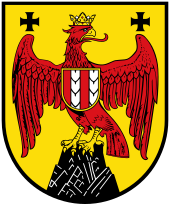Mattersdorf-Forchtenstein
The noble family of the Counts von Mattersdorf-Forchtenstein ( Hungarian : Nagymartoni , later: Fraknói ) was a Hungarian noble family in Burgenland and western Hungary.
history
The Mattersdorf-Forchtensteiner Counts came from Aragon in what is now Spain . After their castle in Mattersdorf was razed, they built Forchtenstein Castle ( Hungarian : Fraknó vára ). The Kobersdorf Castle was also owned by the family. They supported their allies, the Lords of Güns , in the Güssing feud against the Austrian Duke Albrecht I. They were also the founders of the County of Forchtenstein.
In addition to their extensive estates in Hungary , the Counts of Mattersdorf-Forchtenstein also owned several dominions in Lower Austria , Styria and Carinthia . Several Forchtensteiners were married to Austrian aristocrats due to their neighboring location. Wilhelm von Forchtenstein, who died in 1445 without an heir, had his ancestral seat and several other West Hungarian dominions before his death for 150,000 guilders to the later Austrian Duke Albrecht VI. pledged, which, given the emerging Austro-Hungarian threat of war at the time, can only be understood as a "standstill agreement". But when the war actually broke out in the same year, Albrecht occupied Forchtenstein and the other castles after the death of Wilhelm, referring to the pledging, and thus established an almost two-hundred-year phase in which further western Hungarian areas were placed under Austrian administration and tax sovereignty. The family crypt of the Mattersdorf-Forchtensteiners is located in the Neukloster Abbey in Wiener Neustadt .
Family coat of arms

The seal of Count Paul von Mattersdorf as the royal court judge shows an eagle standing on a rock, the wings of which are raised by paw crosses. Allegedly, the family is said to have already used this seal in Spain. The inscription of this seal reads: S.COMITIS.PAULI.IUDICIS.CURIE.REGIS. The seal therefore dates from the period from 1328 to 1349. The family coat of arms corresponding to the seal, of which several variants have been handed down, shows in its most complete form in the white (silver) shield a crowned, gold-reinforced, black eagle soaring from a red rock whose flights are exaggerated by broad-ended red crosses. The family coat of arms of the Mattersdorf-Forchtensteiners is used today as the state coat of arms of Burgenland and also of the Bajót community in the Hungarian Komárom-Esztergom (Komorn-Gran) county .
Burgenland coat of arms

The coat of arms of Burgenland is based on the family coat of arms of the two medieval families of the Counts of Mattersdorf-Forchtenstein and Güns-Güssing . Alfred Anthony von Siegenfeld developed an "ideal version" of the two family coats of arms from the sparse medieval sources : "In silver, a gold-crowned and equally armed black eagle soaring and refusing to stand on a growing red rock, the wings of which are each elevated by a broad-ended red cross" (Mattersdorf-Forchtensteiner) or "a shield split three times by red and furrier" (Güns-Güssinger). The two coats of arms were combined for aesthetic reasons in such a way that the coat of arms of the Güns-Güssinger was placed on the chest of the Mattersdorf-Forchtenstein eagle as a heart shield. This coat of arms was adopted by the Burgenland state parliament on August 1, 1922 as the state coat of arms of Burgenland.
Individual evidence
- ↑ Description of the municipal coat of arms of Bajót based on the family history of the Mattersdorf-Forchtensteiners (accessed on January 27, 2011)
- ↑ Description of the creation of the Burgenland state coat of arms ( Memento of the original from February 20, 2011 in the Internet Archive ) Info: The archive link was inserted automatically and has not yet been checked. Please check the original and archive link according to the instructions and then remove this notice. (accessed on March 3, 2011; PDF; 11 kB)
- ^ Seal of Count Paul von Mattersdorf as royal court judge on the website of the Aplen-Adria University of Klagenfurt (accessed on January 25, 2011)
- ↑ Description of the municipal coat of arms of Bajót based on the family history of the Mattersdorf-Forchtensteiners (accessed on January 27, 2011)
- ^ Coats of arms and colors of Burgenland on the Austria Forum website (accessed on August 25, 2011).